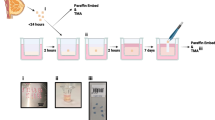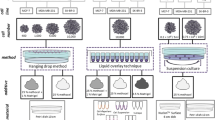Abstract
Purpose
Luciferase modification of tumour cells enables early and non-invasive imaging to detect tumour growth in situ and could provide sensitive and effective detection of carcinoma during research and therapy.
Methods
Renca cells, a murine renal carcinoma cell line, were infected with lentivirus expressing luciferase to obtain Renca-luc. The proliferation, invasion, and migration of Renca and Renca-luc cell lines were compared using colorimetric, Boyden chamber, and wound-healing assays. Orthotopic tumour models were established in BALB/c mice using Renca and Renca-luc cells, and tumour growth in vivo was detected using bioluminescence imaging and magnetic resonance imaging (MRI).
Results
Intensity of luciferase signals from Renca-luc was positively correlated with cell number. Bioluminescence signal was detected 1 day after the establishment of the renal carcinoma model using Renca-luc and was significantly increased after 7 days. Tumour size at 7 days following the establishment of renal carcinoma models using Renca and Renca-luc was determined using MRI. The presence of renal model tumours was confirmed by histological staining. The expression of luciferase did not affect Renca cell characteristics in vitro or tumour growth in vivo.
Conclusion
Luciferase labelling could provide a sensitive and non-invasive evaluation method for immunological and tumour therapy of renal carcinomas.






Similar content being viewed by others
Abbreviations
- MRI:
-
Magnetic resonance imaging
- BLI:
-
Bioluminescence imaging
- RC:
-
Renal carcinoma
- Renca-luc:
-
luc2-labelled Renca line
References
Siegel RL, Miller KD, Jemal A (2017) Cancer statistics, 2017. CA Cancer J Clin 67(1):7–30. doi:10.3322/caac.21387
Siegel RL, Miller KD, Jemal A (2016) Cancer statistics, 2016. CA Cancer J Clin 66(1):7–30. doi:10.3322/caac.21332
Chen W (2015) Cancer statistics: updated cancer burden in China. Chin J Cancer Res 27(1):1. doi:10.3978/j.issn.1000-9604.2015.02.07
Chen W, Zheng R, Baade PD, Zhang S, Zeng H, Bray F, Jemal A, Yu XQ, He J (2016) Cancer statistics in China, 2015. CA Cancer J Clin 66(2):115–132. doi:10.3322/caac.21338
Cancer Genome Atlas Research Network (2013) Comprehensive molecular characterization of clear cell renal cell carcinoma. Nature 499(7456):43–49. doi:10.1038/nature12222
Chen W, Hill H, Christie A, Kim MS, Holloman E, Pavia-Jimenez A, Homayoun F, Ma Y, Patel N, Yell P, Hao G, Yousuf Q, Joyce A, Pedrosa I, Geiger H, Zhang H, Chang J, Gardner KH, Bruick RK, Reeves C, Hwang TH, Courtney K, Frenkel E, Sun X, Zojwalla N, Wong T, Rizzi JP, Wallace EM, Josey JA, Xie Y, Xie XJ, Kapur P, McKay RM, Brugarolas J (2016) Targeting renal cell carcinoma with a HIF-2 antagonist. Nature 539(7627):112–117. doi:10.1038/nature19796
Ukon N, Zhao S, Yu W, Shimizu Y, Nishijima KI, Kubo N, Kitagawa Y, Tamaki N, Higashikawa K, Yasui H, Kuge Y (2016) Dynamic PET evaluation of elevated FLT level after sorafenib treatment in mice bearing human renal cell carcinoma xenograft. EJNMMI Res 6(1):90. doi:10.1186/s13550-016-0246-z
Zhao H, Nolley R, Chan AM, Rankin EB, Peehl DM (2016) Cabozantinib inhibits tumor growth and metastasis of a patient-derived xenograft model of papillary renal cell carcinoma with MET mutation. Cancer Biol Ther. doi:10.1080/15384047.2016.1219816
Asadzadeh F, Ferrucci V, De Antonellis P, Zollo M (2017) In vivo bioluminescence imaging using orthotopic xenografts towards patient’s derived-xenograft Medulloblastoma models. Q J Nucl Med Mol Imaging Off Publ Ital Assoc Nucl Med 61(1):95–101. doi:10.23736/S1824-4785.16.02959-9
Jones L, Richmond J, Evans K, Carol H, Jing D, Kurmasheva RT, Billups CA, Houghton PJ, Smith MA, Lock RB (2017) Bioluminescence imaging enhances analysis of drug responses in a patient-derived xenograft model of pediatric ALL. Clin Cancer Res. doi:10.1158/1078-0432.CCR-16-2392
Ramasawmy R, Johnson SP, Roberts TA, Stuckey DJ, David AL, Pedley RB, Lythgoe MF, Siow B, Walker-Samuel S (2016) Monitoring the growth of an orthotopic tumour xenograft model: multi-modal imaging assessment with benchtop MRI (1T), high-field MRI (9.4T), ultrasound and bioluminescence. PLoS ONE 11(5):e0156162. doi:10.1371/journal.pone.0156162
Au JT, Gonzalez L, Chen CH, Serganova I, Fong Y (2012) Bioluminescence imaging serves as a dynamic marker for guiding and assessing thermal treatment of cancer in a preclinical model. Ann Surg Oncol 19(9):3116–3122. doi:10.1245/s10434-012-2313-7
Schafer H, Schafer A, Kiderlen AF, Masihi KN, Burger R (1997) A highly sensitive cytotoxicity assay based on the release of reporter enzymes, from stably transfected cell lines. J Immunol Methods 204(1):89–98
Chen H, Yao H, Huang L, Shen Q, Jia W, Xue J (2006) Expression of human factor IX gene in murine plasma through lentiviral vector-infected haematopoietic stem cells. Clin Exp Pharmacol Physiol 33(12):1196–1201. doi:10.1111/j.1440-1681.2006.04511.x
Ding J, Wang C, Li PC, Zhao Z, Qian C, Wang CX, Cai Y, Teng GJ (2016) Dual-reporter imaging and its potential application in tracking studies. J Fluoresc 26(1):75–80. doi:10.1007/s10895-015-1673-3
Ding J, Zhao Z, Wang C, Wang CX, Li PC, Qian C, Teng GJ (2016) Bioluminescence imaging of transplanted human endothelial colony-forming cells in an ischemic mouse model. Brain Res 1642:209–218. doi:10.1016/j.brainres.2016.03.045
Wang H, Wang H, Shen W, Huang H, Hu L, Ramdas L, Zhou YH, Liao WS, Fuller GN, Zhang W (2003) Insulin-like growth factor binding protein 2 enhances glioblastoma invasion by activating invasion-enhancing genes. Can Res 63(15):4315–4321
Wang J, Wang H, Zhu R, Liu Q, Fei J, Wang S (2015) Anti-inflammatory activity of curcumin-loaded solid lipid nanoparticles in IL-1β transgenic mice subjected to the lipopolysaccharide-induced sepsis. Biomaterials 53:475–483. doi:10.1016/j.biomaterials.2015.02.116
Wang X, McManus M (2009) Lentivirus production. J Vis Exp. doi:10.3791/1499
Ding J, Wang C, Li PC, Zhao Z, Qian C, Wang CX, Cai Y, Teng GJ (2015) Dual-reporter imaging and its potential application in tracking studies. J Fluoresc. doi:10.1007/s10895-015-1673-3
Vogelzang NJ, Stadler WM (1998) Kidney cancer. Lancet 352(9141):1691–1696. doi:10.1016/S0140-6736(98)01041-1
Gupta K, Miller JD, Li JZ, Russell MW, Charbonneau C (2008) Epidemiologic and socioeconomic burden of metastatic renal cell carcinoma (mRCC): a literature review. Cancer Treat Rev 34(3):193–205. doi:10.1016/j.ctrv.2007.12.001
Siegel R, Naishadham D, Jemal A (2012) Cancer statistics, 2012. CA Cancer J Clin 62(1):10–29. doi:10.3322/caac.20138
Escudier B (2010) Chemo-immunotherapy in RCC: the end of a story. Lancet 375(9715):613–614. doi:10.1016/S0140-6736(10)60209-7
Longo R, D’Andrea MR, Sarmiento R, Salerno F, Gasparini G (2007) Integrated therapy of kidney cancer. Ann Oncol 18(Suppl 6):vi141–vi148. doi:10.1093/annonc/mdm244
Atkins MB, Ernstoff MS, Figlin RA, Flaherty KT, George DJ, Kaelin WG Jr, Kwon ED, Libermann TA, Linehan WM, McDermott DF, Ochoa AC, Pantuck AJ, Rini BI, Rosen MA, Sosman JA, Sukhatme VP, Vieweg JW, Wood CG, King L (2007) Innovations and challenges in renal cell carcinoma: summary statement from the Second Cambridge Conference. Clin Cancer Res 13(2 Pt 2):667s–670s. doi:10.1158/1078-0432.CCR-06-2231
Sadikot RT, Blackwell TS (2005) Bioluminescence imaging. Proc Am Thorac Soc 2(6):537–540, 511–532. doi:10.1513/pats.200507-067DS
Acknowledgements
This research was supported by the Fundamental Research Funds for the Central Universities (No. 2242015k30002). We also thank Adam & Stone Bio-Medicals Ltd Co. for English editing.
Author information
Authors and Affiliations
Contributions
J. Ding conducted all experiments and edited figures; C. Wang integrated data and wrote the manuscript; X. Chang provided essential assistance. All authors discussed the results and approved the manuscript.
Corresponding author
Ethics declarations
Conflict of interest
There are no conflicts of interest to declare.
Ethical approval
The study design was approved by the appropriate ethics review boards. Animal experiments were carried out in accordance with the National Institutes of Health Guide for the Care and Use of Laboratory Animals and were approved by the Laboratory Animal Center of Southeast University.
Electronic supplementary material
Below is the link to the electronic supplementary material.
Rights and permissions
About this article
Cite this article
Ding, J., Wang, C. & Chang, X. Establishment of a bioluminescent Renca cell line for renal carcinoma research. Int Urol Nephrol 50, 55–61 (2018). https://doi.org/10.1007/s11255-017-1707-7
Received:
Accepted:
Published:
Issue Date:
DOI: https://doi.org/10.1007/s11255-017-1707-7




